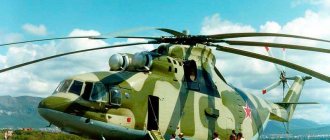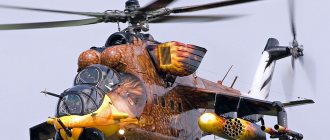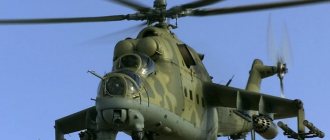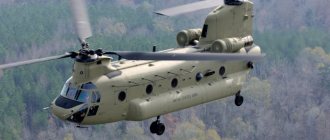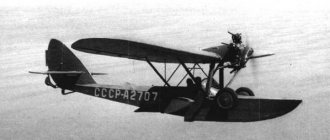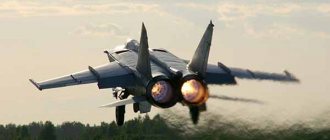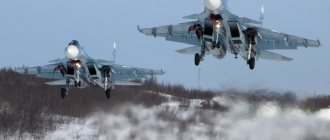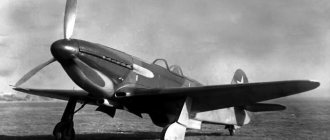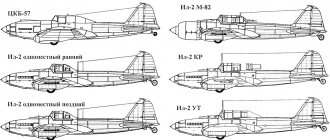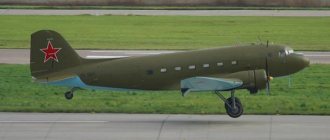The Mi-34 helicopter was developed as a training and sports machine, as well as to replace older models of helicopters that performed these functions. These were mainly Mi-1 and Mi-2 helicopters. The design of the new helicopter was drawn up in Moscow at the legendary Mil helicopter plant. The production of this device was planned at the Transcarpathian plant, where all production was set up and the appropriate equipment was installed. But due to the collapse of the USSR, only one Mi-34 helicopter was manufactured there, which was transferred to the Mil design bureau. After production in Transcarpathia was closed, helicopters of this model began to be manufactured in Arsenyevsk. The Mi-34 made its first test flight in the fall of 1986.
The main purpose of the helicopter is to transport mail, train pilots, business trips, patrol, and it can also be used as a medical center.
Description of the Mi-34 helicopter
The initial model of the helicopter was equipped with an M-14 model power plant from the Ka-26 helicopter, which had a power of 242 kW. This engine model was widely used on sports aircraft. When developing and manufacturing the new helicopter, the newest and highest quality parts and materials were used, as well as simpler designs, which only improved the performance of the machine. By using a simpler chassis, namely a ski type, the helicopter became more practical and received better flight characteristics.
In order for the helicopter to effectively perform its tasks, the designers thought through and calculated the large overloads that it can withstand. It is these characteristics that allow the Mi-34 helicopter to perform various aerobatic maneuvers.
The Mi-34 helicopter can be used as a sports car and compete in international competitions. Today, this machine performs precision and navigation flights, and quite complex sports figures in the air. During testing, this device was able to perform such difficult aerobatic maneuvers as the “barrel”, as well as the “Nesterov loop”. Before this, not a single Soviet helicopter could perform these tasks.
The second prototype of this helicopter model was ready in 1987. At the same time, the Mi-34 was presented at the Paris Aviation and Space Salon, and subsequently at many exhibitions around the world, where it demonstrated its excellent flight characteristics.
In the process of further modernization, the Mi-34 helicopter received broader capabilities. This device was used as a passenger and cargo vehicle. He also served as a patrol air vehicle and carried out communications post tasks.
Helicopter Mi-34began to be developed as a light training and sports helicopter to replace the
Mi-1
and
Mi-2
.
It was initially decided to use the existing M-14V-26 piston engine designed by I.M. as the power plant for the helicopter. Ka-26
helicopters , also taking into account the fact that M-14 engines are widely used on sports aircraft used in DOSAAF.
The use in the development of the Mi-34
of the latest technical advances, new materials in the structure of the fuselage, main rotor and transmission, as well as simpler design solutions, for example, a ski landing gear, made it possible to obtain a helicopter that is simple in design and easy to operate with high flight characteristics. When designing the helicopter, high, calculated overloads were taken into account - from 2.5g to -0.5g, which ensured the performance of complex aerobatics and made it possible to use the helicopter to perform sports exercises according to international competition programs, including flights for precision piloting and navigation and helicopter slalom.
Mi-34 helicopter
made its first flight in November 1986 (test pilot B.V. Savinov, later died during testing of the
Mi-34
), during tests on the
Mi-34
the performance of such aerobatics as the “barrel” and “loop” was demonstrated Nesterov”, a first for our helicopters.
In 1987, construction of the second prototype helicopter was completed; in 1987, the Mi-34
was first shown at the Paris Aviation and Space Show, and then at many other international exhibitions, demonstrating high flight characteristics.
In the process of developing the Mi-34
the possibilities of its use as a multi-purpose helicopter for passenger and cargo transportation, as well as as a communications and patrol helicopter were expanded. A number of helicopter options have been developed:
- Mi-34 VAZ - with two VA3-430 rotary piston engines with a power of 162 kW each, which has better high-altitude characteristics and greater payload capacity and flight range. It was planned that the helicopter Mi-34 VAZ
will make its first flight in 1993, but due to delays in the creation of engines, the creation of the helicopter was also delayed.
At the MAKS-95 exhibition, a model of the Mi-34
with the American Allison-250 gas turbine engine was demonstrated; - Mi-34M - an improved military version of the helicopter Mi-34 VAZ
with the same engines; supposed to be used for target designation and reconnaissance;
- Mi-34 - patrol vehicle for the police, with a lighting headlight and loudspeakers; was first demonstrated at MAKS-95 and at the 27th European Helicopter Forum in St. Petersburg.
The production of helicopters in a small series began at the Arsenyevsky Aviation Plant with their subsequent fine-tuning at the cost center.
DESIGN. A single-rotor helicopter with a tail rotor, one thruster (or two thrusters) and a ski landing gear.
The fuselage has a frame structure made of aluminum alloys with a wide use of CM and smoothly transitions into a conical tail boom with a casing on top for the tail rotor shaft; on the left side, at the end of the tail boom, a swept-back vertical tail with a T-shaped horizontal tail of a rectangular shape in plan is installed.
The cockpit with a large glass area in front houses seats for pilots with dual controls, behind them is a common seat for two passengers; with one pilot, three passengers can be accommodated in the cockpit. There are two doors on the sides of the cabin.
The landing gear is non-retractable, ski-mounted, with a safety support at the lower end of the vertical tail. Chassis ski track 2.06m.
The main rotor is four-bladed, with elastic fastening of the blades. The bushing has horizontal and axial hinges and elastic elements that ensure movement of the blades in the plane of rotation. The blades are rectangular in plan, made of fiberglass reinforced with carbon fibers; blade chord 0.22m, profile NACA 230.
The tail rotor is 1.98 m in diameter, two-bladed, pushing, with a common horizontal hinge. The blades are rectangular in plan, with a chord of 0.1 m, made of fiberglass.
Mi-34 helicopter power plant
consists of one star-shaped nine-cylinder air-cooled piston engine M-14B-26, installed in the central part of the fuselage, equipped with a fan and gearbox. The engine has good throttle response and immunity to exhaust gases entering the air intake, which is very important when performing aerobatics.
The fuel system includes one lightweight tank with a capacity of 160 liters in the central part of the fuselage under the engine and is designed to operate when flying in an inverted position.
The helicopter's control system is mechanical, the cockpit controls are dual, and the controls for the left pilot can be removed.
The equipment consists of a VHF radio station, an automatic radio compass, a radio altimeter, and an attitude indicator.
E.I.Ruzhitsky “Helicopters”, 1997
The helicopter was developed by the Moscow Helicopter Plant named after. M.L. Mil on a proactive basis and is intended for use both in the armed forces (for reconnaissance and surveillance, patrolling and maintaining communications between headquarters) and in the national economy, where it should take the place of obsolete Mi-2
and
Ka-26
.
The first flight of a prototype helicopter took place in November 1986. After lengthy tests, small-scale production of the Mi-34
mastered at the Arsenyevsky Mechanical Plant.
The plant's production capabilities allow it to produce 100-150 machines of this type per year. The Mi-34
is designed using a single-rotor design with a four-blade main and two-blade tail rotors and a lightweight skid landing gear. The all-metal fuselage is divided into crew and passenger cabins, engine and instrument compartments. In order to lighten the helicopter, a number of hatches and hoods are made of composite materials. Composite materials are also used in the structures of the keel, stabilizer and main and tail rotors.
The two-seat crew cabin provides good visibility through the large front and side glazing. The cockpit has dual controls, which allows the helicopter to be used for pilot training. For commercial flights, a passenger may be seated in the co-pilot's seat. Two more passengers can take seats in the passenger compartment. For access to each of the cabins, there is one door on both sides of the fuselage.
The main modification of the helicopter is intended to use a nine-cylinder M-14V-26V piston engine with a power of 242 kW as a power plant. This reliable engine has been well developed by industry and has been widely used on light aircraft. With a fuel consumption of 47 liters per 100 km, the capacity of the fuel tank installed under the engine (160 liters) is sufficient for a flight over a range of more than 300 km.
The helicopter is equipped with a four-bladed main rotor and a two-bladed tail rotor. The propeller blades are made of composite materials and have a rectangular shape in plan. The choice of a four-blade propeller for a helicopter with a take-off weight of only 1450 kg is primarily due to the desire to ensure good controllability of the helicopter, reduce the level of vibration and noise compared to two-blade ones, and shift the vibration spectrum to a higher and, accordingly, safer from a medical point of view, frequency range. The blades made of composite materials have an increased service life and remain operational when shot by bullets. The design of the helicopter as a whole makes it possible to perform maneuvers with an overload of more than three “g” and perform all aerobatics, including the “Nesterov loop” and “barrel”.
Compared to most helicopters in its class, the Mi-34
has much more diverse and advanced avionics equipment. This equipment includes an automatic radio compass ARK-22, a magnetic compass Ki-13K, an attitude indicator AGR-29, a heading system "Crest-1", a radio altimeter A-037, an altimeter VM-15PV, a variometer VAR-30MK and a speed indicator US-350 . The helicopter can also be equipped with satellite navigation system equipment from Allied Signal.
In addition to the basic model of the helicopter with the M-14V-26V engine, several modifications have been developed:
- Mi-34A
- helicopter with
Allison 250-C20R
; - Mi-34VAZ
RPD-430VAZ
rotary piston engines (Wankel type) produced by the Volzhsky Automobile Plant.
With a total engine power of 325 kW
, a helicopter with four passengers on board reaches speeds of up to
180 km/h
. Car gasoline consumption is 25 liters per 100 km; - Mi-34M
is a military modification, which is a variant of
the Mi-34VAZ
with special equipment for target designation and reconnaissance.
The Mi-34M
helicopter made its first test flight in 1993. - Mi-34P
is a patrol helicopter for traffic control.
The helicopter is equipped with a powerful headlight and loudspeaker. To carry out patrol flights at night, it is possible to install a thermal imager from the Israeli company Elbit
; - Mi-34S
is a modification that has passed state, certification and operational tests and has helicopter type, engine type and noise type certificates issued by the Aviation Register of the Interstate Committee.
All of the listed modifications are unarmed. however, as the experience of the world helicopter industry shows, on almost every helicopter it is possible to mount removable consoles to accommodate suspended weapons and install the corresponding sighting devices.
V.N. Shunkov “Combat Helicopters”, 1999
Technical data the Mi-34
Power plant: 1 x 9-cylinder star-shaped PD Vedeneev M-14V26
power
242 kW
, main rotor diameter:
10.0 m
, fuselage length:
8.71 m
, take-off weight:
1350 kg
, empty weight:
800 kg
, fuel capacity:
120 kg
, maximum speed:
210 km/h
, cruising speed:
180 km/h
, rate of climb:
9.15 m/ s
, dynamic ceiling:
4500m
, static ceiling:
1500m
, flight range with a load of 90kg:
450km
Design of the Mi-34 multi-purpose helicopter
The helicopter has a standard single-rotor helicopter design using a tail rotor. The chassis has a simplified design and is represented by skis.
The body is made of aluminum alloy, where CM is widely used, after which the structure passes into the tail boom, on which the casing for the tail rotor is located. The tail boom is equipped with a swept tail on the left side. The cockpit has a large glass area, which provides greater visibility during maneuvers. The helicopter can be controlled by either two or one pilot; control is duplicated for both pilots. Behind the pilots there are two more seats for passengers. There are two doors on each side of the cabin.
The main rotor is represented by a four-blade system, and the blades are elastically attached. The bushing and hinges ensure reliable and elastic rotation of the screw in the horizontal plane. The main rotor blades are rectangular in shape and made of fiberglass reinforced with carbon fiber. The machine's tail rotor has a diameter of 1.98 meters. It consists of two blades that have a pushing function and are also made of fiberglass.
The Mi-34 helicopter is equipped with a nine-cylinder power plant, which is air cooled. The engine is installed in the middle of the helicopter body, equipped with a gearbox and a cooling fan. The power plant has high throttle response and is insensitive to exhaust entering the air intake. The latter characteristic is very important for helicopters that perform very complex maneuvers or sports figures.
The helicopter's tank has a small volume, only 160 liters. It is located in the central part of the machine body and can provide fuel to the engine even in an inverted position. The entire control system is completely mechanical and has a redundant system for two pilots. If not needed, the controls for the left pilot can be removed. The cockpit has modern equipment, which includes an altimeter, radio station, attitude indicator and radio compass.
Specifications
- Length - 8851
- Height - 2750
- Main rotor diameter - 10m
- Weight - 1137 kg
- Crew - 1-2
- Number of passengers - 2-3
- Maximum take-off weight - 1450 kg
- The engine used as a power plant is 1 x PD M-14V26V, with a power of 1 x 325 hp. With.
- Maximum speed - 200 km/h
- Cruising speed - 155 km/h
- Practical range - 349 km
- Practical/Static ceiling – 900m / 4000m
- The maximum ferry range is 700 km.
Modifications of the Mi-34 helicopter
The most successful modification can be considered the Mi-34 VAZ model, which is equipped with two piston engines that have a power of 430 horsepower. This power plant provides the vehicle with a large payload and provides a significant flight range.
The designers planned to produce this model in 1993. Unfortunately, there was a delay in development, and this modification was first presented in 1995 at an exhibition. The designers also produced a military vehicle called the Mi-34M, which should perform reconnaissance.
For the needs of the police, a helicopter was manufactured that is capable of conducting patrols. For this task it was equipped with a spotlight and a loudspeaker. In addition to all these models, there is a helicopter that is equipped with a gas turbine power plant of the Allison 250 model. All modifications of the Mi-34 helicopter do not have any weapons. But the practice of using similar vehicles shows that they can be equipped with various weapons and sighting equipment.
Operators
As of February 27, 2013
[1]
- Russia, Russia
- OKB M. L. Mil - 2 experimental helicopters of the Mi-34S1 modification.
- Romania Romania
- 2 Mi-34S helicopters registered to private individuals.
- New Zealand New Zealand
- An unnamed New Zealand company purchased six Mi-34S helicopters from the Nigerian Air Force in 2013. All delivered in December 2013. Of these, four are undergoing repairs at the aircraft repair company Heli Maintenance, one was dismantled for parts, and the fate of another damaged helicopter is not determined K: Wikipedia: Articles without sources (type: not specified)[ source not specified 2107 days
]
Former operators
- Russia, Russia
- Main Department of Internal Affairs of Moscow - 2 Mi-34
- Bashkir Airlines - 5 Mi-34S
- Kazakhstan Kazakhstan
- Aviation service of the Central Internal Affairs Directorate of Almaty - in 2003, 2 Mi-34S helicopters were purchased for the aviation service of the Central Internal Affairs Directorate of Almaty, but due to the low power of the engines and, consequently, the low altitude of the helicopters, operation was discontinued[11].
- Nigeria Nigeria
- Nigerian Air Force - a total of 9 Mi-34S helicopters were delivered to Nigeria in 2001-2002, which were planned to be used as training machines for pilots flying the Mi-35P. But during operation, a low service life of the main rotor gearbox was discovered (300 hours instead of the 1.5 thousand declared upon sale) and operation was discontinued when the service life was exhausted[12].
- Bosnia and Herzegovina Bosnia and Herzegovina
- Air Force of Bosnia and Herzegovina - 1 Mi-34, purchased for pilot training in the late 90s.
Sports achievements of the Mi-34
For the first time in the history of Russian helicopter aviation, our team took part in international sports competitions in the summer of 2007. It became the main sponsor. As a result of these competitions, we were able to take prizes in the championships of such countries as Italy, England and France.
The Mi-34 helicopter was originally designed by order of DOSAAF and the Ministry of Defense for helicopter sports and pilot training. The Mi-34S1 variation has more than 100 modifications compared to its predecessor, the Mi-34S.
The new modern Mi-34S1 helicopter has the highest global standards of maneuverability, safety, ease of maintenance, pilot comfort and operating costs. The operational and flight characteristics of the Mi-34S1 helicopter give it the ability to effectively work as a helicopter for initial training and increasing flight skills, for private and corporate transportation, all types of monitoring (including monitoring fire-hazardous areas, performing police functions and monitoring gas and oil pipelines ), use in agricultural aviation, training of civil pilots, use in firefighting, as well as use as a sports helicopter.
Mi-34S1 photo
Main functions of the helicopter:
- Education
- Transport
- Agriculture
- Monitoring (including pipeline monitoring and police functions)
- Sport
- Firefighting
Mi-34S1 photo
Description of design
The Mi-34 is a single-rotor helicopter with four-bladed main rotors and two-bladed tail rotors. This design provides excellent controllability of the air machine, reduces noise and vibration levels compared to a two-bladed device.
During the creation of the Mi-34, the developers took the path of simplifying the design and using high-quality materials. As a result, the machine was designed to withstand large overloads on the helicopter structure. Thanks to these qualities, the car was able to participate in sports competitions. The Mi-34 is the first model in the history of Russian helicopter manufacturing that managed to produce such elements of the aerobatics series as the “Nesterov loop” and “barrel”. The model took part in a large number of sporting competitions, where she showed good results.
Read The best-in-class multi-purpose helicopter Mi-38
Skids are used as the chassis. The fuselage is made of aluminum alloy and is divided into a cockpit and a passenger compartment. There are two doors on the sides of the fuselage. Excellent visibility for the crew is provided by the large area of the glass front of the Mi-34. In addition to metal, the helicopter body contains composite materials that significantly reduce weight: the Mi-34 weighs only 1,450 kg. Hatches and hoods, parts of the keel and stabilizer, steering and main rotors are made from them.
The helicopter has dual controls. In total, the Mi-34 can take four people on board. The machine is unpretentious in maintenance and easy to use. For takeoff and landing, it will be “arranged” with concrete and dirt platforms.
Notes
- ↑ 12
[russianplanes.net/planelist/Mil/Mi-34 Register of helicopters of the Mil Mi-34 type]. russianplanes.net. Retrieved February 3, 2013. [www.webcitation.org/6EMAZoFOR Archived from the original on February 11, 2013]. - A. Rossikhin, N. Bezkorovayny, A. Guseva.
[www.aviajournal.com/arhiv/1999/1099/st3b_1099.html What helicopters does Ukraine need?]. General Aviation (October 1999). Retrieved May 8, 2014. [www.webcitation.org/6PPl8S1Hn Archived from the original on May 8, 2014]. - [www.dsnews.ua/politics/art37033 Ready for takeoff! The country's only state-owned helicopter manufacturer is on the path to bankruptcy]. DsNews (September 1, 2008). Retrieved May 8, 2014. [www.webcitation.org/6PPlHIZia Archived from the original May 8, 2014].
- ↑ 12
[interfax.ru/news.asp?id=178270 Flight tests of the Mi-34S1 helicopter will begin this summer] (Russian) - [interfax.ru/news.asp?id=180275 Russian Mi-34S1 helicopter presented in the USA] (Russian)
- [www.russianhelicopters.aero/ru/press/publications/3285.html The Ministry of Industry and Trade decided to merge the Kamov Design Bureau and the Mil Design Bureau], Russian Helicopters, 09/27/2012
- Igor Lot.
[www.mosoblpress.ru/mass_media/3/126/item96404/ Disappearance of the MI-34 project]. Moscow Region News Agency. Retrieved February 5, 2014. [www.webcitation.org/6N9nykRFG Archived from the original on February 5, 2014]. - Irina Ivanova
[www.helicopter.su/assets/files/zhurnal/07/0708.pdf The Russian “Hermit” is mastering Europe] // Helicopter industry: magazine. - 2007. - No. 8. - P. 4-8. [www.webcitation.org/6EHsIybzx Archived] from the original February 8, 2013. - [www.take-off.ru/pdf/03_2008.pdf Mi-34 - now without a pilot] // Takeoff: magazine. - 2008. - No. 3. - P. 5. - ISSN [www.sigla.ru/table.jsp?f=8&t=3&v0=1819-1754&f=1003&t=1&v1=&f=4&t=2&v2=&f=21&t=3&v3 =&f=1016&t=3&v4=&f=1016&t=3&v5=&bf=4&b=&d=0&ys=&ye=&lng=&ft=&mt=&dt=&vol=&pt=&iss=&ps=&pe=&tr=&tro=&cc=UNION&i=1&v =tagged&s=0&ss=0&st=0&i18n=ru&rlf=&psz=20&bs=20&ce=hJfuypee8JzzufeGmImYYIpZKRJeeOeeWGJIZRrRRrdmtdeee88NJJJJpeeefTJ3peKJJ3UWWPtzzzzzzzzzzzzzzzzbzzvzzpy5 zzjzzzzzzzzzzzzzzzzzzzzzzzzzzzzzztzzzzzzzbzzzzzzzzzzzzzzzzzzzzzzzzzzzzzzzzzzzyeyTjkDnyHzTuueKZePz9decyzzLzzzL*.c8.NzrGJJvufeeeeeJheeyzjeeeeJ h*peeeeKJJJJJJJJJmjHvOJJJJJJJJfeeeieeeeSJJJJJSJJJ3TeIJJJJ3..E.UEAcyhxD.eeeeeuzzzLJJJJ5.e8JJJheeeeeeeeeeeeeeeK3JJJJJJJJ*s7defeeeeeeeeeeeeeeeeeeeeeeeeSJJJJJJJJ ZIJJzzz1..6LJJJJJJtJJZ4….EK*&debug=false 1819-1754] . [www.webcitation.org/6EHqMxf6M Archived] from the original February 8, 2013.
- [aviadocs.net/RLE/Mi-34S/CD1/RLYE/Mi-34S_RLYE.pdf Mi-34S. Flight Manual]. Retrieved February 9, 2013. [www.webcitation.org/6EMAavyzN Archived from the original on February 11, 2013].
- Elena Yafyazova.
[wap.gazeta.kz/article/71988/ From the screw!]. Gazeta.kz. Retrieved February 27, 2013. [www.webcitation.org/6F0WKc9W5 Archived from the original on March 10, 2013]. - [ria.ru/defense_safety/20110726/407432949.html The Nigerian Air Force decided to sell Russian Mi-34 helicopters]. RIA Novosti (July 26, 2011). Retrieved February 27, 2013. [www.webcitation.org/6F0WLI5OA Archived from the original on March 10, 2013].
- [russianplanes.net/reginfo/41799 LA card]. russianplanes.net. Retrieved February 14, 2013. [www.webcitation.org/6ESBfDVIj Archived from the original on February 15, 2013].
- [index.hu/bulvar/gep0713/ Csak a farokrészét tudták kiemelni a Dunába zuhant gépnek] (Hungarian). Index.hu (July 13, 2008). Retrieved February 14, 2013. [www.webcitation.org/6ESGG4Et9 Archived from the original on February 15, 2013].
